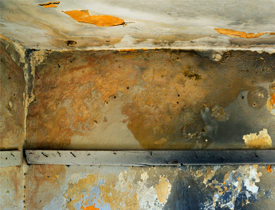Mold Growth in the Garage
 As you probably know, mold tends to pop up anywhere. You can find it on last week’s loaf of bread or in an old container of mystery food (also known as the kid’s science experiment) way back in the fridge. Mold doesn’t need much to take hold -- just a bit of moisture and food. When you throw in some warmth and a little time, countless unseen spores will start to grow and reproduce.
As you probably know, mold tends to pop up anywhere. You can find it on last week’s loaf of bread or in an old container of mystery food (also known as the kid’s science experiment) way back in the fridge. Mold doesn’t need much to take hold -- just a bit of moisture and food. When you throw in some warmth and a little time, countless unseen spores will start to grow and reproduce.
Many people suffer ill effects from exposure to mold, so keeping it at bay is always a good idea. There are many ways to curtail mold’s growth and spread; mold cleanup can range from full-scale warfare armed with a host of toxic chemicals to a gentler, more commonsense approach using natural materials. Here's how to clear up mold growth in the garage.
Break the Cycle
Just as firefighters have been trained to remove one of fire's 3 required components (air, fuel and heat), mold works in a similar way with moisture, food and spores. Remove the food -- mold does not grow. Remove the moisture -- same result.
The commonest food sources for mold in a garage are the paper found on drywall and the wood that holds it all up. Replacing the drywall with a paperless version or building with steel studs is a great way to limit mold growth in new construction, but it tends to be a costly and involved retrofit in older homes. Find drywall contractors near you to safely replace your moldy drywall.
Taking away the moisture is a better place to focus your efforts. A simple coat of paint can often be the barrier you need to keep moisture away from the drywall’s paper. Repair of minor leakage in roofs and siding also helps. When you drive your car into the garage after snow or rain, most of that dampness will stay inside for some time. Stop it from adding to moisture and mold problems; drains and proper floor slope can work wonders.
Harsh Chemicals or Natural Products
Historically, the weapon of choice for homeowners and their mold cleanup battles has been bleach. Today many find vinegar equally effective in mold abatement. Tea tree oil mixed with water is another natural alternative, as is a solution of grapefruit seed extract. These products are pricey compared to vinegar, but keep in mind that only small quantities (normally 1-2 teaspoons to 2 cups of water) are needed. Lots of people use these products in areas where vinegar may damage the surface they're trying to clean; for instance, on marble.
Since a garage mold cleanup project may be quite large, economical options here are preferred. Borax is one such cost-effective choice. Borax contains elemental boron which is used in many commercial applications for pest and fungicidal control. Borax can be found in your local supermarket in the laundry section, and a simple water-borax solution can be very effective at mold cleanup.
More Cleaning Options
Baking soda, hydrogen peroxide and ammonia are some other common cleaners used in mold cleanup. However, baking soda and hydrogen peroxide are much more user-friendly than ammonia, which should never be used with bleach. Those two chemicals in combination produce deadly chlorine gas.
Prevention is always a better option than remediation. Keep in mind how the mold growth cycle is constructed and you can reduce the chance that a large mold cleanup will be required. If, however, your defenses have slipped and this pesky fungus has invaded your life, there are a handful of options out there that are both natural and effective.
Updated February 26, 2018.
Looking for a Pro? Call us (866) 441-6648

Cleaning Average Costs
Cleaning Services Experiences

Replacement Of A Light Fixture That Literally Fell Off The Ceiling

Find A Handyman Who Responds Fast And Knows His Stuff



